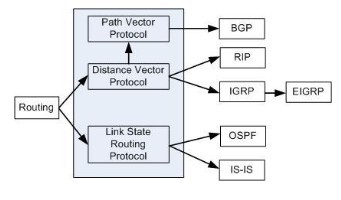Definition of Routing Protocol in Network Encyclopedia.
What is Routing Protocol?
Routing Protocol is a protocol that enables the exchange of routing tables between routers in an internetwork. Routing protocols are the software implementation of specific routing algorithms, which are mathematical procedures for determining the cost of various paths or routes through an internetwork so that traffic can be routed most efficiently.

Routing protocols are generally implemented in medium to large-sized TCP/IP internetworks to simplify the administration of routing tables. Common routing protocols include the following:
- Routing Information Protocol (RIP): Based on the distance vector routing algorithm and used in small to medium-sized internetworks. RIP is an intradomain routing protocol that can function only within a given routing domain. Microsoft Windows NT Server and Microsoft Windows 2000 Server support RIP; a multihomed machine running Windows NT or Windows 2000 can be used as a RIP router.
- Interior Gateway Protocol (IGP): Based on the distance vector routing algorithm and used in medium-sized to large-sized internetworks. IGP is an intradomain routing protocol that can function only within a given routing domain. IGP uses a number of metrics to determine routing cost, including load, bandwidth, latency, reliability, and Maximum Transmission Unit (MTU). The router determines some of these factors dynamically as it inspects incoming traffic, while others are specified by the network administrator. IGP supports multipath routing for load balancing and fault tolerance.
- Open Shortest Path First (OSPF) Protocol: Based on the link state routing algorithm and used in medium-sized to large-sized internetworks. OSPF is an intradomain routing protocol that can function only within a given routing domain. OSPF is also a hierarchical routing protocol that can be used within a single autonomous system. OSPF evolved from the earlier Open Systems Interconnection (OSI) reference model routing protocol called intermediate-system-to-intermediate-system (IS–IS). OSPF supports multipath routing and uses one or more routing metrics, including bandwidth, reliability, load, latency, and MTU. If OSPF uses more than one metric, it also supports type-of-service (TOS) requests for differentiating traffic.
- Exterior Gateway Protocol (EGP): An interdomain routing protocol for routing between different routing domains that are connected by a routing backbone such as the Internet. EGP was specifically designed in 1984 as the protocol for communication between the core or backbone routers of the Internet. EGP does not use routing metrics – it simply keeps track of which networks are currently reachable through a given router.
- Border Gateway Protocol (BGP): Another interdomain routing protocol created specifically to enable the core or backbone routers of the Internet to communicate with each other. BGP is superior to EGP because it can detect routing loops and use routing metrics.
- NetWare Link Services Protocol (NLSP): Used in Novell NetWare 4.x as part of its Multi-Protocol Router (MPR). NLSP is based on a combination of OSPF routing and Novell’s Service Advertising Protocol (SAP) functions and is also based on the link state routing algorithm.
- Routing Table Maintenance Protocol (RTMP): Used in AppleTalk networks and based on the distance vector routing algorithm. RTMP is derived from RIP.
NOTE
Dynamic routers talk to each other using routing protocols and are essentially self-configuring (except for the first one installed in an internetwork). Static routers do not talk to each other and must be configured independently.
TIP
Remember that a routing protocol is different from a routable protocol. A routing protocol is used by routers to communicate with each other. A routable protocol, on the other hand, is a network protocol such as TCP/IP or IPX/SPX that can be routed between networks within an internetwork.